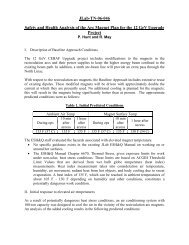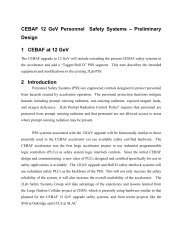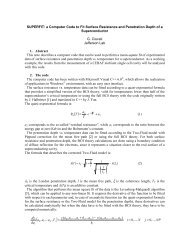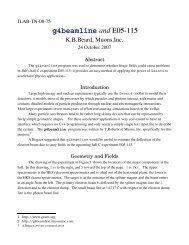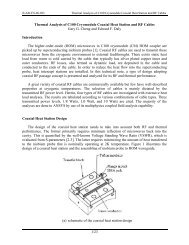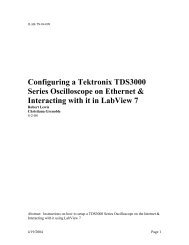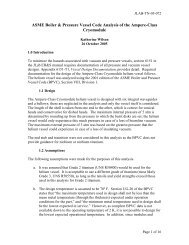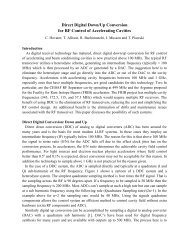Workshop on Polarized Electron Sources and Polarimeters
Workshop on Polarized Electron Sources and Polarimeters
Workshop on Polarized Electron Sources and Polarimeters
Create successful ePaper yourself
Turn your PDF publications into a flip-book with our unique Google optimized e-Paper software.
Optimizati<strong>on</strong> of Semic<strong>on</strong>ductor Superlattice for<br />
Spin <strong>Polarized</strong> Electr<strong>on</strong> Source<br />
L. G. Gerchikov a , Yu. A. Mamaev a , V. V. Kuz’michev a , Yu. P.Yashin a ,<br />
V. S. Mikhrin b , A. P. Vasiliev b , A. E. Zhukov b<br />
a St. Petersburg State Polytechnic University, Russia<br />
b A. F. Ioffe Physicotechnical Institute RAS, Russia<br />
Abstract. Optimized AlInGaAs/AlGaAs superlattice with strained quantum wells has been<br />
developed, fabricated <strong>and</strong> studied. The choice of hetero-layer compositi<strong>on</strong> <strong>and</strong> thicknesses is<br />
based <strong>on</strong> calculati<strong>on</strong>s of Sl’s b<strong>and</strong> energy spectrum, photoabsorpti<strong>on</strong> spectrum <strong>and</strong> transport<br />
properties. Electr<strong>on</strong> emissi<strong>on</strong> from the developed photocathodes dem<strong>on</strong>strates maximal<br />
polarizati<strong>on</strong> above 90%.<br />
Keywords: Polarizati<strong>on</strong>, Photoemissi<strong>on</strong>, Superlattice.<br />
PACS: 72.25.Fe,73.21.Cd,79.60.-i<br />
INTRODUCTION<br />
The use of short-period superlattices (SL) opens up wide possibilities for b<strong>and</strong><br />
structure engineering of photoemitter working layer. The optimal choice of SL’s<br />
layers compositi<strong>on</strong> <strong>and</strong> thickness providing the high energy splitting of the valence<br />
b<strong>and</strong> together with good transport properties for photoelectr<strong>on</strong>s have made it possible<br />
to design photocathodes with electr<strong>on</strong> polarizati<strong>on</strong> above 90% [1-3]. Photocathodes<br />
based <strong>on</strong> GaAs/GaAsP [1] <strong>and</strong> AlInGaAs/GaAlAs [2] SL structures with strained<br />
quantum wells (QW), GaAs/AlInGaAs-based SLs [3] with strained barriers, <strong>and</strong> socalled<br />
compensated SLs based <strong>on</strong> AlInGaAs/GaAsP SL structures with opposite<br />
strains in the wells <strong>and</strong> barriers [4] have been developed.<br />
These studies have also revealed several fundamental difficulties for achieving<br />
further progress. High electr<strong>on</strong>ic polarizati<strong>on</strong>, P, is achieved at the expense of<br />
quantum efficiency, QE. Indeed, the maximal spin orientati<strong>on</strong> of photoelectr<strong>on</strong>s takes<br />
place at the photoabsorpti<strong>on</strong> threshold where the light absorpti<strong>on</strong> coefficient is rather<br />
small. Maximal polarizati<strong>on</strong> of photoelectr<strong>on</strong>s is limited by the mixture of light <strong>and</strong><br />
heavy hole states which takes place even at the absorpti<strong>on</strong> edge due to the broadening<br />
of the valence b<strong>and</strong> energy spectrum <strong>and</strong> smearing of the valence b<strong>and</strong> edge. The<br />
mixture of light <strong>and</strong> heavy hole states can be reduced by increasing the energy<br />
splitting ∆Ehh–lh between the hh <strong>and</strong> lh subb<strong>and</strong>s. However the splitting of SL valence<br />
b<strong>and</strong> due to the deformati<strong>on</strong> is limited by some critical value. Deformati<strong>on</strong> bey<strong>on</strong>d<br />
this level results in structural defects, smaller residual strain <strong>and</strong> lower polarizati<strong>on</strong>.



